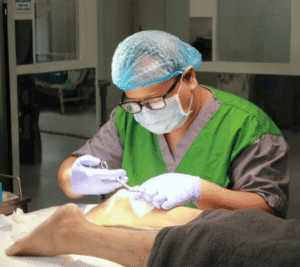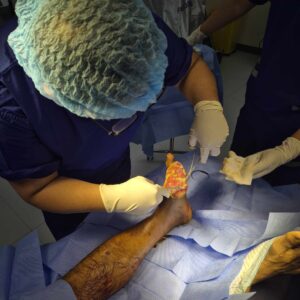Understanding the Role of a Doctor for Wound Dressing
A doctor for wound dressing plays a critical role in managing wounds to ensure proper healing and avoid complications. Wound dressing is more than just covering a cut or scrape; it involves careful assessment and treatment to create the ideal environment for tissue repair. Medical professionals who specialize in wound care understand the unique needs of various wounds, such as surgical incisions, pressure ulcers, burns, or injuries caused by accidents. Each type of wound requires different dressing materials and techniques to promote healing while preventing infection. When wounds are left untreated or dressed improperly, they may worsen, leading to delayed recovery or serious health issues. Doctors trained in wound dressing use their knowledge to select appropriate dressings, apply them correctly, and monitor the wound’s progress regularly. Their expertise can make a significant difference in both healing speed and the patient’s comfort throughout the process.
When to See a Doctor for Wound Dressing
Recognizing when to seek professional help for wound dressing is vital to avoid complications. If a wound is deep, bleeding heavily, or shows signs of infection—such as redness, swelling, warmth, or discharge—it’s time to consult a doctor. Delaying treatment can allow bacteria to multiply, increasing the risk of infection or even systemic issues like sepsis. Some wounds, especially those caused by surgery or in people with conditions like diabetes, require close medical supervision. Wounds that fail to heal after several days or worsen over time also warrant medical attention. Self-treatment may work for minor cuts and scrapes, but complicated wounds demand specialized care. A doctor for wound dressing can accurately assess the wound’s severity and recommend the best treatment options to avoid long-term damage. This proactive approach can prevent unnecessary pain and reduce overall healthcare costs.
What to Expect During a Doctor’s Wound Dressing Appointment
Visiting a doctor for wound dressing involves a thorough evaluation to ensure the wound is healing properly. The doctor will first examine the wound’s size, depth, and appearance, looking for any signs of infection or complications. Depending on the wound type, they may clean it using sterile solutions to remove debris and bacteria. This cleaning process is crucial for preventing infection and creating a healthy environment for tissue repair. The doctor will then choose the most suitable dressing material, which might include gauze, hydrocolloids, or specialized films designed to keep moisture balance optimal. Sometimes, antibiotics or topical treatments are applied to combat infection. Patients can expect the doctor to explain the care routine and offer pain management options if the dressing process causes discomfort. Follow-up appointments are usually scheduled to monitor healing and make necessary adjustments to the dressing technique.
Benefits of Professional Wound Dressing by a Doctor
Professional wound dressing performed by a doctor can greatly improve healing outcomes and reduce complications. Skilled medical care ensures that wounds are kept clean and properly protected from harmful bacteria. This reduces the risk of infections that can cause pain, scarring, or serious illness. A doctor can tailor treatment plans based on the wound’s condition and the patient’s overall health, which is especially important for chronic wounds or wounds in patients with underlying conditions. Proper wound management also helps minimize scarring by maintaining an ideal healing environment. Additionally, doctors provide guidance on lifestyle adjustments and wound care at home, ensuring continuous healing. Early intervention by a wound care specialist often results in shorter recovery times and a better quality of life for patients dealing with wounds.
Common Treatments and Advanced Wound Care Options
Wound dressing today combines traditional methods with innovative technologies designed to enhance healing. Conventional dressings like gauze and bandages are still widely used, but advanced options such as hydrocolloid dressings, alginate dressings, and foam dressings have become popular for their moisture-retaining and antibacterial properties. Doctors may apply antiseptics or antibiotics topically to prevent or treat infections. For wounds that are slow to heal, advanced treatments like negative pressure wound therapy or skin grafts might be considered. Surgical debridement, where dead tissue is removed, can also be necessary for wounds with extensive damage or infection. Each treatment is customized to the patient’s specific wound type and health needs. Staying up-to-date with the latest wound care advances allows doctors to offer the most effective healing solutions, reducing discomfort and recovery time.
Home Care Advice and Follow-Up After Doctor’s Wound Dressing
Proper care at home complements the medical attention received during doctor visits and plays a big role in wound healing. Patients should follow all instructions carefully, including keeping the wound clean and dry, changing dressings as advised, and avoiding activities that may reopen or aggravate the wound. It is important to watch for any signs of infection, such as increased redness, swelling, foul odor, or unusual discharge, and seek medical help promptly if they occur. Nutrition and hydration also support the body’s healing ability, so maintaining a balanced diet can make a difference. Keeping follow-up appointments with the doctor allows for ongoing assessment and timely adjustments to treatment. Adhering to these practices ensures the wound is healing steadily and helps prevent setbacks that could prolong recovery.
Choosing the Right Doctor for Wound Dressing
Selecting a qualified doctor for wound dressing can be challenging but is essential for effective care. Look for medical professionals who specialize in wound care or have specific training in this area. Wound care specialists often work within multidisciplinary teams that include nurses, physical therapists, and surgeons, providing comprehensive care tailored to each patient. Referrals from primary care physicians or hospital discharge planners can help locate experienced wound care providers. Checking credentials, patient reviews, and the availability of advanced wound care treatments can also guide the decision. Access to a clinic or specialist near your location adds convenience for frequent dressing changes and monitoring. Ultimately, a skilled and compassionate doctor will ensure the wound heals efficiently while addressing any concerns along the way.
Frequently Asked Questions (FAQ)
How often should wound dressings be changed by a doctor?
The frequency of dressing changes depends on the wound type, size, and healing stage. Some wounds may require daily dressing changes, while others can be changed every few days. A doctor will provide a schedule tailored to the wound’s condition to promote optimal healing.
Can wounds heal without professional dressing?
Minor wounds may heal with basic home care, but wounds that are deep, infected, or chronic need professional wound dressing to avoid complications. Proper medical care prevents infection and accelerates recovery.
What are the risks of ignoring wound care?
Ignoring proper wound care can lead to infection, delayed healing, scarring, or in severe cases, systemic infections that require hospitalization. Chronic wounds may become ulcers or lead to loss of tissue if untreated.
Are there special considerations for diabetic or elderly patients?
Yes, diabetic and elderly patients often have slower healing due to reduced circulation and immune function. They require more frequent monitoring and specialized wound care to avoid serious complications.
How to manage pain during wound dressing?
Doctors may use topical anesthetics or recommend pain medications to reduce discomfort during dressing changes. Proper technique and gentle handling during dressing application also help minimize pain.






